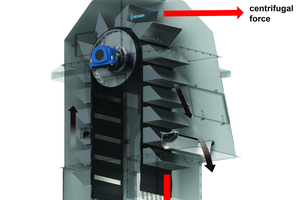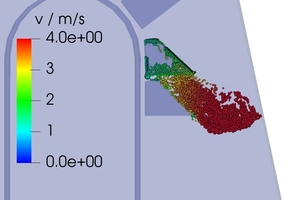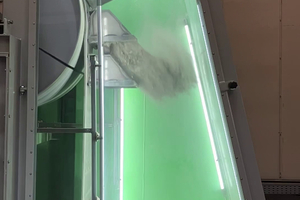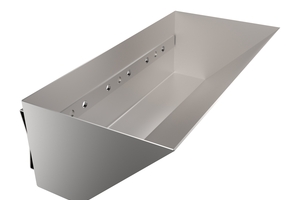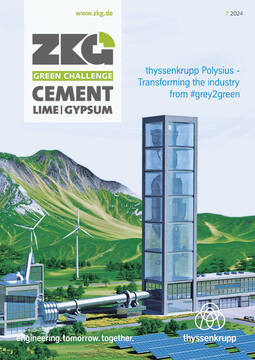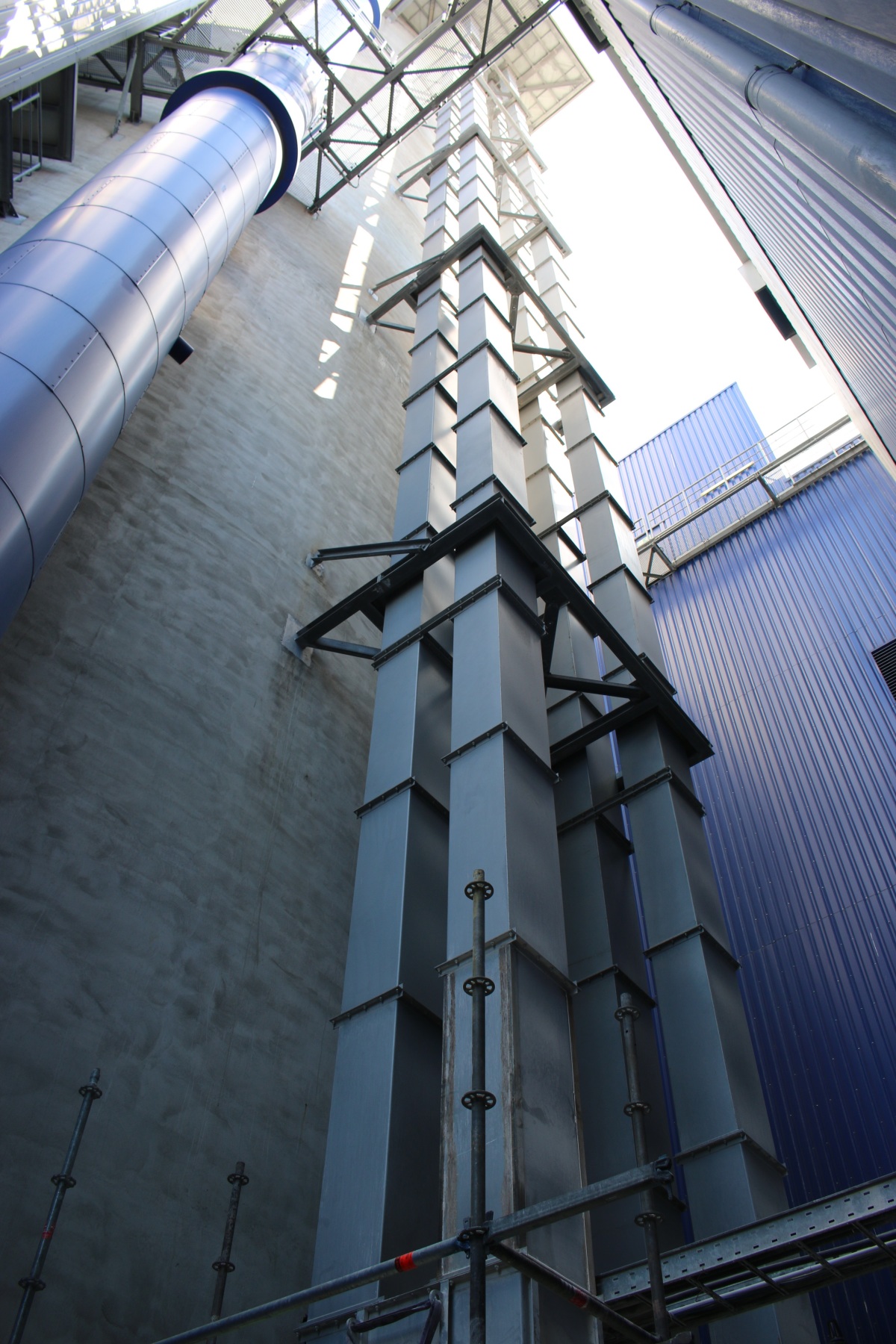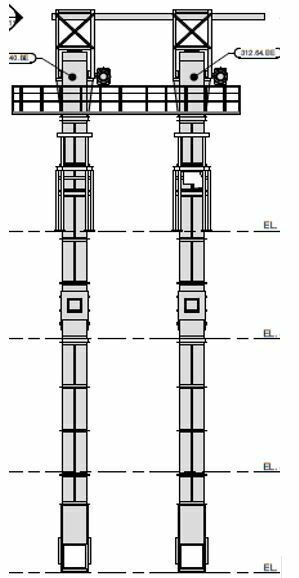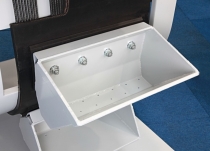Bucket elevators: game-changing bucket redesign delivers major efficiency, safety and sustainability benefits
Claus Weyhofen explains how Beumer Group’s determination to reduce backfall in lifting operations led them to reassess and optimise the design of the elevator bucket, resulting in a far more efficient machine that delivers major benefits for the global cement industry.
Bucket elevators are the work-horses of the cement industry. They are used to vertically convey bulk materials ranging from powders like fly ash, alumina, raw meal, and cements with up to 5000 Blaine fines, to coarse materials like gravel, cement clinker and re-circuit materials for roller press and vertical roller mill grinding. Using a belt or chain mechanism, these high capacity, heavy duty machines rely on a combination of centrifugal and gravimetric forces to eject the bulk material out of each bucket when it reaches the desired height.
The basic design of the bucket elevator has not changed for decades – but it is far from perfect. Efficiency is an ongoing challenge, with many operations experiencing backfall levels higher than 20%. Beumer Group has undertaken a detailed study of the performance characteristics of bucket elevators to identify key areas for improvement. The outcomes have informed a total redesign of the bucket itself, as well as the fixing and tipping points (as seen in Figure 1). This article explains the research findings and how they affect bucket elevator design. It also spells out the significant benefits that are now available to the global cement industry by implementing the new-design bucket elevators.
Backfall challenges
Backfall of bulk material, though wasteful, has become an accepted part of lifting operations. Backfall is caused by an improper ratio between the centrifugal and gravimetric forces, or by bulk material (and/or mixtures of the same) whose flow behaviours make a proper discharge extremely difficult. Instead of ejecting cleanly from the bucket into the bucket elevator head outlet, material falls behind the adjustable sealing blade and accumulates in the boot of the elevator.
An average backfall of 8% to 10% is still considered to be normal for most kinds of applications. However, there are applications for bucket elevators in milling circuits behind a roller press or vertical roller mill where discharge behaviour is even worse, often exceeding 20% backfall. In other words, bucket elevators are currently only around 70% to 90% efficient.
Backfall material needs to be recovered, which involves scooping it out of the bucket elevator boot and lifting it back to the top of the elevator: effectively performing the same task twice. This raises several issues.
Crucially, backfall recovery increases energy consumption because the same material is effectively being lifted twice. For example, if a bucket elevator lifts 100 t and 25% of this quantity needs to be recovered as backfall, the energy bill is going to be 25% higher than it needs to be. Bearing in mind that approximately 95% of the power consumption of a bucket elevator is expended in lifting up bulk materials, there are clear efficiency, cost and sustainability benefits if that material is lifted and discharged cleanly the first time.
Working harder to lift the same amount of material can impact on operational safety and efficiency as well. Worn shaft casings and increased motor current are inevitable consequences of lifting heavy loads repeatedly, and ultimately lead to problems with conveying capacity. Inefficient material discharge also creates a lot of wear and tear to the descending bucket elevator casing as well as to the buckets themselves, which means they need replacing more frequently. This not only affects production by increasing downtime while repairs are made, it also requires more resources: including steel, which has a high carbon footprint.
For an industry that is under increasing pressure to be more efficient and more sustainable, the current levels of backfall are no longer acceptable at either an operational or an environmental level. So, can bucket elevator design be improved to dramatically reduce backfall levels?
Bucket testing
There are three key influencers on bucket elevator performance:
bulk material (density and grain size)
angle velocity of bucket (speed at circumference)
bucket shape (dimension and fixation)
Adapting an influencer changes the ratio between gravimetric and centrifugal forces to affect the behaviour of the bucket elevator. It is therefore necessary to establish the optimum combination of forces that allow the material time to discharge effectively with minimal or no backfall at typical speeds of 1.5 to slightly more than 2 m/sec. Equipment manufacturers have no control over the first of these parameters, as material specification is dictated by the application. However, the angle velocity and shape of the bucket can be investigated to determine how much these affect backfall.
Beumer Group used digital DEM (Discreet Element Method) techniques to map and understand the behaviour of our existing bucket elevator design and its effect on the discharge for different materials, ranging from coarse clinker to finest cements. The theoretical results were subsequently verified by conducting discharge tests at their research and development facility in Beckum, Germany (see Figure 2). These tests comprised manual weighing and filling of the bucket, compacting to replicate the effects of vibration, and collection and weighing of the ejected material and backfill material.
The aim was to optimise the discharge parabola so material passes over the discharge lip and into the outlet without falling into the boot, and without hitting the casing, the bucket below or the head casing front wall. The results have led to a significant alteration in the 30-year-old design of our established belt and chain bucket elevators.
Design optimisation
The new design uses the same drum diameter as before, but is able to run at slightly higher speeds. As a result, the new design can operate reliably at certain speed ranges, for example between 1.64 to 2.06 m/sec. This higher velocity range allows the optimum speed for a particular bulk material to be applied and can be adjusted even after installation, improving discharge and minimising backfall.
Further changes have been made to the bucket profile and to where the bucket attaches to the belt or chain (see Figure 3). Testing showed that moving the fixing point for the new buckets further down allows earlier activation of the centrifugal forces, activating the ejecting process of bulk material at an earlier point, which again increases discharge efficiency.
Backfall of coarse materials such as clinker, gypsum and gravel under testing was so low as to be not measurable – even when the buckets were overloaded.
Benefits
The new bucket design and lower fixing point on belt and chain bucket elevators delivers several benefits for cement producers.
Up to 98% efficiency by optimising discharge at the elevator head
Reduction in energy consumption due to reduction in backfall
Improved discharge efficiency, with various speed range options enabling centrifugal forces to be matched to bulk material properties
Reduced OPEX, through a combination of less wear and tear on equipment, less rework and therefore lower energy bills
Up to 25% weight saving on tall bucket elevators (e.g. kiln or silo feed), thanks to smaller buckets and housings
Lower carbon footprint, not only through lower energy consumption but also due to less steel being required for bucket elevator production
Taken together, these benefits mean that the new design delivers the highest efficiency for bucket elevators in the market.
Customer applications
The new design bucket elevators are already delivering benefits in real cement industry applications involving both light and dense materials. A European customer had been experiencing problems for more than a decade with a bucket elevator associated with a roller press at their cement mill. Their Beumer Bucket Elevator was originally installed in 2003 to lift clinker flakes at a rate of 750 t/hr. It had been retrofitted by a market competitor in 2013 in an attempt to reduce backfall issues experienced since installation, but without success. Recirculation of backfall material continued to cause premature wearing of the shaft casings to such an extent that the plates needed replacing regularly.
The worn shaft casings were of particular concern because, in bucket elevators, they generally not only function as enclosures, but also as a load-bearing structure. There is a risk of static failure if they become too worn.
In order to help this customer, Beumer obtained a material sample and tested the discharge behaviour in Beckum with the third-party bucket design. Reproducing the poor discharge behaviour enabled the solution. By redesigning the buckets, Beumer succeeded in reducing the backfall from 15% to 3%. These results were so compelling that the customer ordered a retrofit to the new bucket design immediately.
Conclusion
The cement industry faces many pressures in balancing global demand for its products with continuing calls for more sustainable ways of operating. Just because we have always done things a certain way does not mean there is no room for improvement. The bucket elevator is a prime example. Beumer Group hopes that the results of the extensive study into the behaviour of materials during discharge and the subsequent improvements to bucket elevator design will support cement producers in finding new ways to be more efficient and sustainable while remaining competitive.

